Japanese biker gang membership is at an all time low. Remember when these bosozoku sorts used to be instantly recognizable and intimidating with their leather-clad militaristic styles and wicked hair? Unfortunately all this has changed. Along with gang membership being dangerously low, they aren’t even dressing as flashy as they used to. Being in a Japanese motorcycle gang just ain’t what it used to be.
But before we get into that, let’s explore what these bosozoku used to be so we can really see how far they’ve fallen. They used to strike fear into neighborhoods, terrorize locals, and lead to yakuza membership. Today’s bosozoku pale in comparison. So what were they like in the beginning?
Bosozoku and Their Heyday
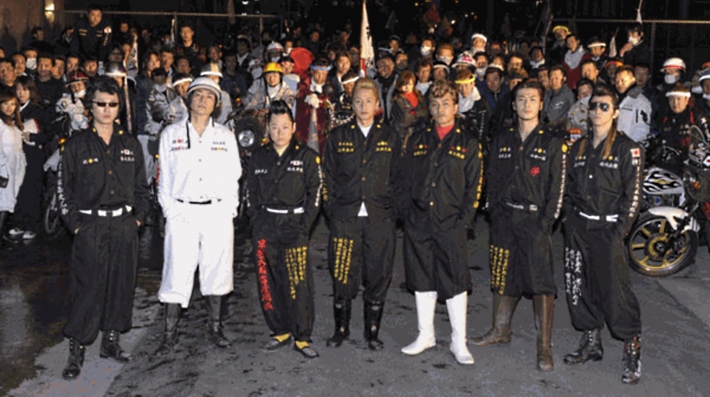
The first bosozoku started popping up in Japan in the 1950s when Japan’s automobile industry started to expand. These early hooligans were known as kaminari zoku or “thunder tribe.” Many of these kaminari zoku came from lower class families and joined up for many of the same reasons people in all countries join gangs. These reasons include dissatisfaction with the system, government, or just their place in society. These members joined up to feel like they were part of something bigger while at the same time sticking it to the man.
Members are almost always under the legal age of 20, and their anti-establishment attitudes and lack of respect for authority set them apart from the normal teenager in Japan. Many dedicated members move on to become low ranking members of the yakuza after their 20th birthday or so because in Japan, you can do everything once you turn 20.
This video is from a bosozoku documentary filmed a handful of years ago.
Reaching their peak in the 80s and 90s, the modern bosozoku were infamous for illegally modding their bikes, making noise, causing disturbances, driving recklessly, weaving in traffic, not wearing protective headwear, running red lights, speeding, and being a pain in Japan’s collective butt. They were also known to gather in the hundreds and drive slowly though suburbs, blocking traffic and waving imperial Japanese flags while creating an unbelievable uproar with their illegally modified mufflers.
Japanese biker gang members were also known for starting fights and terrorizing people with wooden swords, metal pipes, baseball bats, and even Molotov cocktails. They would vandalize cars and beat up anyone who got in their way. Foreigners were always a favorite target for their aggression. Clearly they were a force to be reckoned with.
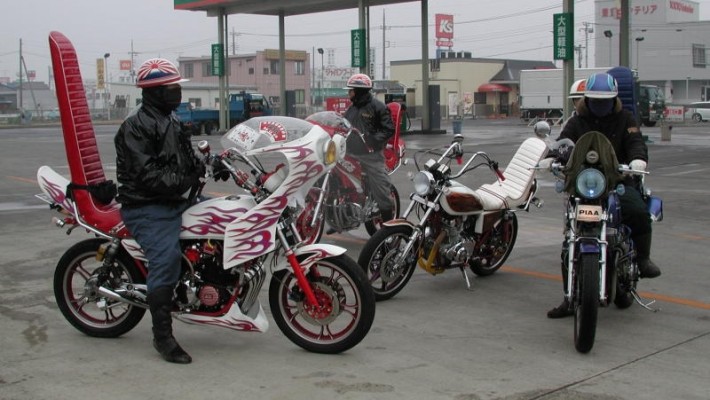
However, membership of the bosozoku has fallen from an all time high of 42,510 in 1982 to an all time low of 9,064 in 2011. This was due in no small part to new laws being passed in 2004 which gave the police more power to arrest groups of reckless bikers. With more arrests and prosecutions being carried out, the gangs started becoming less brazen in their ways. As a result, membership fell and the members started to not be as extroverted as they once were. Some even started driving dinky little scooters instead of the heavily motorized motorbikes that became synonymous with the classic bosozoku image.
Bosozoku Bikes

Along with their flashy clothing, bosozoku are most well known for their extravagant motorcycles. Their typical ride would consist of a normal Japanese road bike combined with elements of an American chopper and a British café racer. These mods included oversized fairings (the shell over the frame), raised handlebars, large seat backs, and colorful paint jobs. These bikes are very unique and definitely have a style all their own.
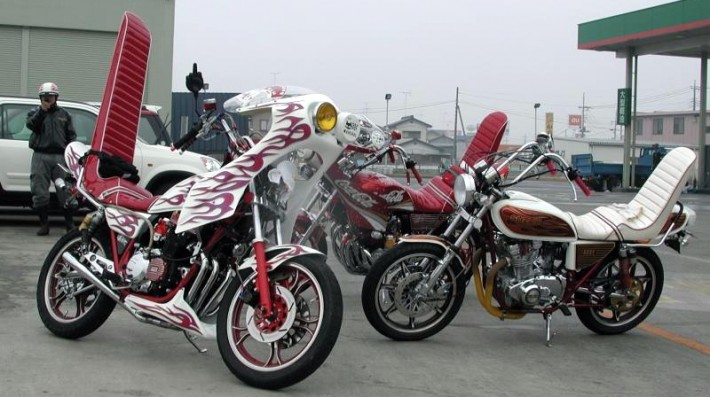
Styles would also vary by region. Apart from gang symbols or logos on the bikes, some regional differences were marked by distinct modifications such as heavy use of lights or multiple oversized fairings. Regardless of the regional differences, when you saw a bosozoku bike, you knew it was from a Japanese biker gang. Most of the time you wouldn’t even have to see the thing to know it was bosozoku. Usually you’d hear these things long before you could see them. Those modded mufflers are loud.
The Traditional Bosozoku
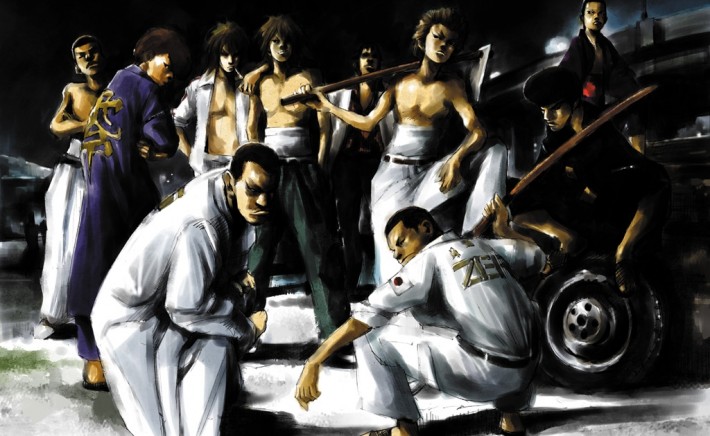
Since bosozoku are so infamously well known in Japan, they are often featured in anime, movies, and TV shows. The stereotypical Japanese bikers are instantly recognizable with their jumpsuit uniforms or kanji adorned military jackets worn open with no shirt to show off their bandaged torsos. They would also wear baggy pants and tall boots to complete the look.
These uniforms became known as tokko-fuku or “special attack uniform” which was also the name given to kamikaze pilots during the war. To complete the look, the uniforms would be adorned with slogans, gang symbols, flags, and even manji. Leather outfits were also common. For accessories, they favored wrap around sunglasses, hachimaki headbands, surgical masks, and both pompadour and punch perm hairstlyes.
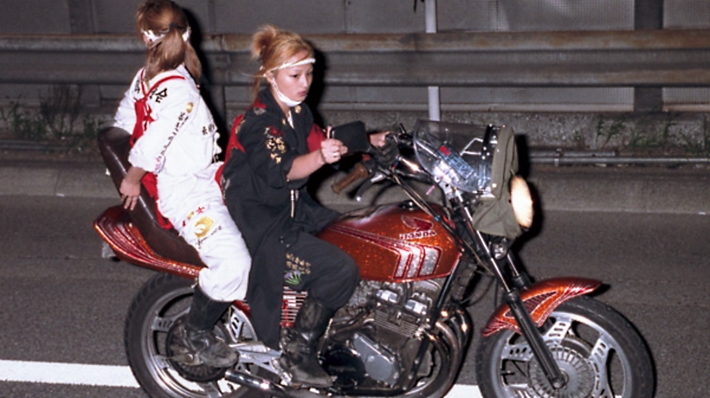
Female members, although less common, would dress in a similar manner. They were known to wear high heeled boots, excessive make-up, and have long, dyed hair. It also was not unusual for them to wear skirts and stockings instead of the more traditional baggy pants.
The Sad Decline of Bosozoku
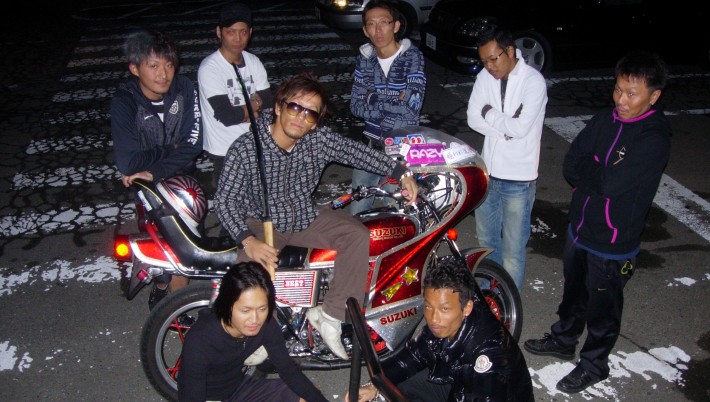
Like I mentioned before, bosozoku membership has reached an all time low since their peak in 1982. Along with newer, stricter regulations imposed by police officers, there are a number of other factors to be considered. These new threats to the Japanese biker lifestyle have encouraged them to ride in smaller groups, ride scooters instead of motorcylces, and generally be more tame and less annoying than ever before.
The new laws passed in 2004 make it easier for Japan’s police to arrest large groups of bikers all at once, and with the global economy in a recession, Japanese hooligans just don’t have as much extra cash to spend on bike mods as they used to. Spending lavish amounts of money on flashy clothes and motorcycle upgrades just isn’t as easy as it used to be. Therefore today’s bosozoku are much more likely to buy scooters instead of bikes, and just wear their everyday street clothes while riding. Some of them even wear helmets. So uncool.
It’s also been suggested that everyday distractions of the modern world also contribute to discouraging today’s youth from getting involved with the gangs. I mean, why spend all that time and money getting involved with a real gang risking arrest when you can just vent your angsty teenage feelings in games like Grand Theft Auto V and Yakuza 4? Much more efficient.
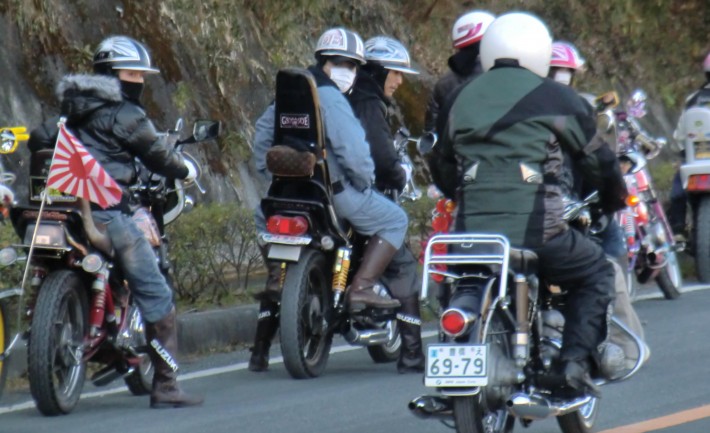
These days bosozoku are harder to identify than ever before. Long gone are the stylized and flashy looks I described to you above. Today’s gang members are much more likely just to dress like anyone else their age. This combined with a lack of members in general has made the presence of Japanese biker gangs much less noticeable in society. It’s also made Japan’s streets much quieter.
So basically, the bosozoku have gone from rambunctious, highly stylized hoodlums riding around on ridiculous motor machines to a much more tame and common looking group of lousy kids riding around on scooters. Oh how the mighty have fallen.
And speaking of the fallen mighty, these guys are from the gang known as Black Shadow. They’re a bit older than the traditional bosozoku, and they like to pass the time dancing around in the park. Not very intimidating for a gang if you ask me.
